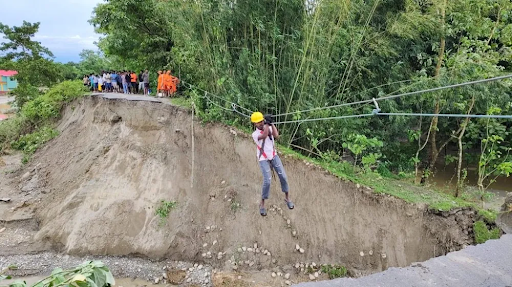Description

Disclaimer: Copyright infringement not intended.
Context: Two teams of experts have been sent to six high-risk glacial lakes in Arunachal Pradesh for the first time to assess the possibility of glacial lake outburst floods (GLOF).
What are Glacial lakes?
- A glacial lake is a body of water with origins from glacier activity. They are formed when a glacier erodes the land and then melts, filling the depression created by the glacier.
How glacial lakes form?
- As glaciers move, they erode the terrain under them, leaving depressions and grooves on the land.
- When they churn up rock and soil, they etch ridges of debris known as moraines.
- Most glacial lakes form when a glacier retreats and meltwater fills the hole left behind.
- However, natural dams, formed out of ice and terminal moraines, can also form glacial lakes.
- Dams formed by moraines can be dense and stable, holding sizable lakes behind them for years.
- They can also be leaky, allowing the lake to drain slowly into nearby rivers.
How they become risk?
- Prolonged melting or abrupt bursts of intense melting can wreak havoc.
- A rise in the amount of meltwater from glaciers increases the water pressure on the moraine barriers, which can quickly give way and threaten inundation.
- Too much meltwater in a short period of time might overflow a lake or burst through natural barriers.
- Lakes held back by moraines pose a serious threat because the porous moraine walls can destabilize easily.
GLOF (Glacial Lake Outburst Flood) and LLOF (Landslide Lake Outburst Flood):
GLOF (Glacial Lake Outburst Flood):
- A GLOF is a flood resulting from the sudden and rapid release of water from a glacial lake, often caused by the failure of a moraine dam or ice dam.

Triggering Mechanism:
- The primary trigger for a GLOF is the collapse or breach of a moraine dam or ice dam holding back water in a glacial lake. This can be caused by factors such as glacial melt water, avalanches, or volcanic activity, earthquake.
Geographical Distribution:
- Commonly associated with glacial regions, especially in mountainous areas with significant glacial activity. Examples include the Himalayas, Andes, and Alps.
- In India- Western Himalayas and Eastern Himalayas.
Human Induced formation of high risk glacial lakes.
- The incidence and frequency of GLOFs is bound to increase in the wake of climate change.
- The Hindukush-Himalayan region were rapidly retreating under the influence global warming.
- The warmer temperatures in the Northern parts of Sikkim gave rise to formation of 203 new glacial lakes.
- A 2021 study confirms that the area at greatest risk for glacial outburst floods is centered in the eastern Himalaya, posing life-threatening scenarios downstream.
- The eastern Himalayas, which are at a lower latitude than the western Himalayas, are relatively warmer.
- As warming continues, threats may triple by 2050, with more hot spots emerging farther west.
Risk Factors:
- Climate change-induced glacial melt, seismic activity, and changes in glacial morphology are key risk factors for GLOFs.
Impacts:
- GLOFs can result in devastating downstream flooding, destruction of infrastructure, and loss of life. The rapid release of water can pose serious threats to communities located downstream.
Examples of GLOFs
- Chamoli floods, Uttarakhand (2021): caused by melting of Nanda Devi glacier.
- In 2023 october, South Lhonak Lake in Sikkim, a glacier-formed lake, overflowed and inundated several parts of the Northeastern State killing at least 40 people and destroying the Chungthang dam.
Steps taken by India to prevent GLOFs
- Sendai Framework (2015-2030) : It is a global blueprint for disaster risk reduction and prevention.
- Coalition for Disaster Resilient Infrastructure : CDRI is an international climate initiative by India in 2019 to promote resilient climate-proof critical infrastructure in member countries.
- National Disaster Management Authority to monitor 189 high-risk glacial lakes to prevent disasters.
- The Central Water Commission in an October 2023 report stated that 902 glacial lakes and waterbodies are being monitored via satellite.
- Aapda Mitra: Launched in 2016, it is a central sector scheme implemented by NDMA to train community volunteers in disaster response.
- The National Glacial Lake Outburst Floods Risk Mitigation Programme was approved by the Centre.
- Arunachal Pradesh State Disaster Management Authority has sent two teams to six high-risk glacial lakes in the Tawang and Dibang Valley districts to study them.
- There are nearly 7,500 glacial lakes in the Himalayan mountain ranges located in India and some of them are being monitored through remote sensing.
Challenges in program implementation
- Fully assessing their impact is only possible with site visits, which is difficult owing to inhospitable terrain.


Mitigation Strategies:
- Risk assessment and Hazard mapping: Utilizes satellite imagery and remote sensing technology to monitor changes in glacial lakes and identify potential threats.
- Establishes ground-based monitoring stations strategically located in high-risk areas. These stations measure parameters such as water level, temperature, and seismic activity, contributing to the overall surveillance and early warning system.
- Engages local communities in the surveillance process, fostering awareness and understanding of the risks.
- Establishes early warning systems that can quickly communicate alerts to communities downstream, enabling timely evacuation and emergency response.
- Artificial drainage: Lowering the water level of glacial lakes can significantly reduce the risk of outburst floods.
Conclusion
The Glacial Lake Outburst Flood and Landslide Lake Outburst Surveillance System thus combines advanced technology, scientific expertise, and community involvement to create a robust framework for monitoring, predicting, and mitigating the risks associated with these natural hazards.
Details:
https://www.iasgyan.in/daily-current-affairs/glacial-lake-outburst-flood-glof
https://www.iasgyan.in/daily-current-affairs/glacial-lakes
Source:
http://www.cryoscience.net/pub/pdf/2012ger_sakai.pdf
https://ndma.gov.in/sites/default/files/PDF/Guidelines/Guidelines-on-Management-of-GLOFs.pdf
|
PRACTICE QUESTIONS
Q. What are Glacial Lake Outburst Floods (GLOFs)? How do they pose a threat to life and property in the Himalayan Regions? Mention the measures to mitigate the effects of such events. 200 words
|















